
The red slender loris is a small, nocturnal strepsirrhine primate native to the rainforests of Sri Lanka. This is No. 6 of the 10 focal species and No. 22 of the 100 EDGE mammal species worldwide considered the most evolutionarily distinct and globally endangered. Two subspecies have been identified, L. t. tardigradus and L. t. nycticeboides.
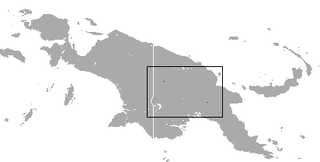
Bulmer's fruit bat is a megabat endemic to New Guinea. It is listed as a critically endangered species due to habitat loss and hunting. It is the only member of the genus Aproteles. Due to its imperiled status, it is identified by the Alliance for Zero Extinction as a species in danger of imminent extinction.

The Telefomin cuscus is a critically endangered possum found on New Guinea.
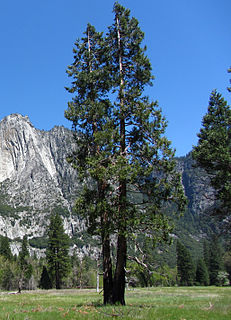
Calocedrus decurrens, with the common names incense cedar and California incense-cedar, is a species of conifer native to western North America. It is the most widely known species in the genus, and is often simply called 'incense cedar' without the regional qualifier.
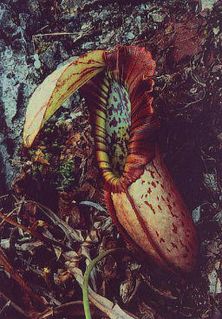
Nepenthes northiana, or Miss North's pitcher-plant, is a tropical pitcher plant endemic to Borneo, where it grows at elevations ranging from 0 to 500 m above sea level. The specific epithet northiana honours Marianne North, who first illustrated the species. Nepenthes northiana is one of the most famous Nepenthes, and its discovery in the latter half of the 19th century contributed to Sarawak's reputation as a land of spectacular exotic plants.

Acacia decurrens, commonly known as black wattle or early green wattle, is a perennial tree or shrub native to eastern New South Wales, including Sydney, the Greater Blue Mountains Area, the Hunter Region, and south west to the Australian Capital Territory. It grows to a height of 2–15 m (7–50 ft) and it flowers from July to September.
Humboldtia bourdillonii is a species of in the family Fabaceae. It is thought to be found only in India, and is threatened by habitat loss.
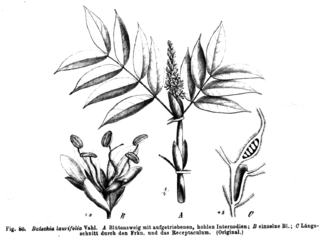
Humboldtia laurifolia is a species of plant in the family Fabaceae. It is native to Kerala and Sri Lanka.

Juniperus angosturana, or slender oneseed juniper, is a species of conifer in the family Cupressaceae.

Protea comptonii, also known as saddleback sugarbush, is a smallish tree of the genus Protea in the family Proteaceae. It is found in South Africa and Eswatini.

Grevillea obtecta is a spreading shrub which is endemic to Victoria, Australia. It is known by the common names Fryerstown grevillea, Elphinstone grevillea, or Taradale grevillea. It grows to 0.5 metres in height and about 1.2 m in width The flowers, which are light green to yellow, appear between August and November in its native range.
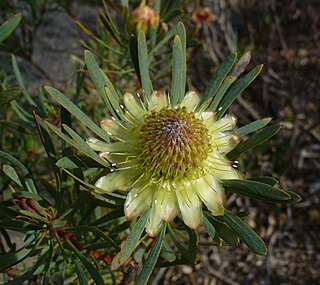
Protea scolymocephala, also known as the thistle protea or thistle sugarbush, is a flowering plant from the genus Protea native to South Africa.

Evecliptopera is a monotypic moth genus in the family Geometridae described by Inoue in 1982. Its only species, Evecliptopera decurrens, first described by Frederic Moore in 1888, is found in northern India, Nepal, south-western China, Japan, the Russian Far East and Taiwan.

Hakea decurrens, commonly known as bushy needlewood, is a species of shrub or small tree in the family Proteaceae.

Helcogramma decurrens, known commonly as the black-throated triplefin, is a species of triplefin blenny in the genus Helcogramma. It was described by Allan Riverstone McCulloch and Edgar Ravenswood Waite in 1918. This species occurs along the western and southern coasts of Australia where it is found down to depths of 13 metres (43 ft) in both the intertidal and subtidal zones where it hides among algae growing on rocky substrates.
Palaquium decurrens is a tree in the family Sapotaceae. The specific epithet decurrens means "running down", referring to the leaf base.
Rhinolophus microglobosus is a species of horseshoe bat found in Southeast Asia.
Fusaea decurrens is a species of plant in the family Annonaceae. It is native to Peru. Robert Elias Fries. The Swedish botanist who first formally described the species, named it after wings of the leaves that run down the stem of the leaf.
Protea decurrens, also known as linear-leaf sugarbush, is a shrub of the genus Protea, in the Proteaceae family, which is endemic to the southwestern Cape Region of South Africa. It is a small shrub with a thick underground rootstock, this structure throwing up numerous leafy branches, upon the base of which clusters of flower heads may appear close to the ground. It is pollinated by rodents and grows in low-altitude fynbos or renosterveld.















